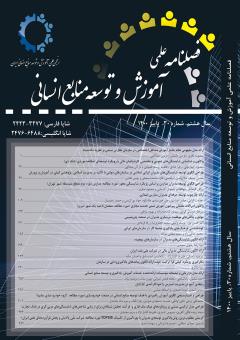طراحي مدل بازاریابی و تبليغات مؤسسات ارائه دهنده خدمات آموزش، یادگیری و توسعه منابع انسانی
محورهای موضوعی : همسوسازي استراتژي هاي يادگيري و توسعه با استراتژي سازماناحمد شانیان 1 , رضا شافعی 2 , تحفه قبادي لموكي 3 , بهروز بیات 4 , مرضیه بیات 5
1 - دانشگاه آزاد اسلامي واحد همدان
2 - دانشگاه کردستان
3 - دانشگاه آزاد اسلامي واحد همدان
4 - دانشگاه آزاد اسلامي واحد همدان
5 - دانشگاه آزاد اسلامي واحد همدان
کلید واژه: مدل بازاریابی, تئوری زمینه ای, مؤسسه آموزش و توسعه منابع انسانی.,
چکیده مقاله :
مطالعه حاضر با استفاده از رویکرد کیفی و روش تئوری زمینه ای برای طراحی مدل بازاریابی مؤسسات ارائه دهنده خدمات آموزش و توسعه منابع انسانی انجام شد. جامعه مورد مطالعه شامل مدیران مؤسسات ارئه دهنده خدمات آموزشی و توسعه منابع انسانی بود که از طریق نمونه گیری هدفمند شناسایی و انتخاب شدند. داده ها از طریق مصاحبه ها جمع آوری شد. یافته ها حاکی از آن است که عواملی نظیر شناخت سازمان های بزرگ و صنایع و دانستن مسائل و مشکلات آنها، مهارت های کارکنان موسسات آموزشی، انگیزه کارکنان موسسه، بانک های اطلاعاتی قوی ، استفاده از فناوری های نوین آموزشی، بسته بندی مناسب خدمات آموزشی، خدمات جانبی جذاب در موسسه، ارائه نمونه های موفق کارهای قبل، مدرسان باتجربه، برخورداری از استانداردهای آموزشی، مناسب بودن فضای آموزش ، سیستم تامین رضایت مشتری ، اعتبار مدارک و اخذ مجوزهای موسسه، شناخت رقبا ، شرایط اقتصادی جامعه و مردم، بحران های سیاسی، اجتماعی و زیستی و قیمت ها از جمله عوامل اصلی تأثیرگذار بر بازاریابی مؤسسات آموزش و توسعه منابع انسانی می باشند. در مدل تحقیق، افزایش درآمد، توسعه برند، افزایش قدرت در توسعه مدرسان و مربیان و توسعه اعتبار ملی، از پیامدهای به کارگیری راهبردهای مناسب برای بازاریابی مؤسسه آموزش و توسعه منابع انسانی استخراج گردید.
The present study was conducted using the qualitative approach and the grounded theory method to design the marketing model of the Institute of Education and Human Resources Development. The study population included the managers of educational institutions who were selected through purposive sampling. The data was collected through interviews. The findings showed that factors such as identifying large organizations and industries and knowing their issues and problems, skills of the staff of the educational institution, staffs’ motivation, strong databases, use of new educational technologies, proper packaging of educational services, attractive ancillary services in the institution, providing examples successful previous work, experienced instructors, having educational standards, appropriate training environment, customer satisfaction system, competitors, political, social and biological crises and prices affect marketing the Institute of Education and Human Resources Development. In the research model, increasing revenue, developing a brand, increasing power in developing instructors and educators, and developing national credibility were the consequences of the use of appropriate strategies for marketing the Institute of Education and Human Resources Development.
عليزاده ثاني، م.، نجات، س. (1394). بررسي تأثير جذابيت برند كارفرما بر تمايل استخدام نخبگان (مطالعة موردي: شركت¬هاي زير مجموعة وزارت نفت). نشريه مديريت بازرگاني، 8(1)، 228-205.
محمدی¬ها، پریا.، محمد داودی، امیرحسین. و مصلح، مریم. (1398). بازاریابی آموزشی دانشگاه آزاد راهبردی برای توسعه پایدار. طب و تزکیه، 28(3)، 97-84.
نجفي سياهرودي، م.، علوي، س.، ابراهيمي، ا. (1393). اثر هويت¬سازي برند بر اقدام¬هاي ضدبرند با ميانجي¬گري عشق به برند و حسادت به برند. نشريه مديريت بازرگاني، 7(3)، 543 -562.
یاسینی، علی.، عباسی نیکو، محمد.، تابان، محمد. و پوراشرف، یاسان¬الله. (1396). طراحي الگوي بازاريابي آموزش عالي در ايران؛ مدلي برآمده از نظرية داده بنياد. مدیریت بازرگانی، 9(2)، 438-415.
Al-Husseini, S., and Elbeltagi, I. (2016). Transformational leadership and innovation: a comparison study between Iraq’s public and private higher education. Studies in Higher Education, 41(1), 159-181
. Bunnell, T. (2005). Strategic marketing planning in international schools. International Journal of Educational Management, 19(1), 59-66
. Constantinides, E. & Zinck Stagno, M. C. (2011). Potential of the social media as instruments of higher education marketing: a segmentation study. Journal of Marketing for Higher Education, 21(1), 7-24
. Enache, I. C. (2011). Marketing higher education using the 7 Ps framework. Bulletin of the Transilvania University of Brasov. Economic Sciences. Series V, 4(1), 23, 23-30
İşcioğlu, M., and İşcioğlu, T. E. (2017). HIGHER EDUCATION MARKETING: A COMPARATIVE ANALYSIS OF PUBLIC AND FOUNDATION UNIVERSITIES IN TURKEY. Beykoz Akademi Dergisi; 5(2), 196-231
Manea, N., and Purcaru, M. (2017). The Evolution of Educational Marketing. Annals of Spiru Haret University, Economic Series 17, no. 4, 37-45
. Maniu, I., and Maniu, G. C. (2014). EDUCATIONAL MARKETING: FACTORS INFLUENCING THE SELECTION OF A UNIVERSITY. SEA: Practical Application of Science, 2(3). Pp 37-42
Maringe, F., and Mourad, M. (2012). Marketing for Higher Education in Developing Countries: emphases and omissions. pp 1-9
. Mok, K. (2003). Globalization and restructuring higher education in Hong Kong, Taiwan and mainland China. Higher Education Research and Development, 22(2), 117- 129
. Wiese, M (2008). A higher education marketing perspective on the factors and information sources considered by South
African first year university students (Doctoral dissertation, University of Pretoria). Wiese, M., van Heerden, N., Jordaan, Y. & North, E. (2009). A marketing perspective on choice factors considered by South African first-year students in selecting a higher education institution, Southern African Business Review, 13(1), 39-60
.


